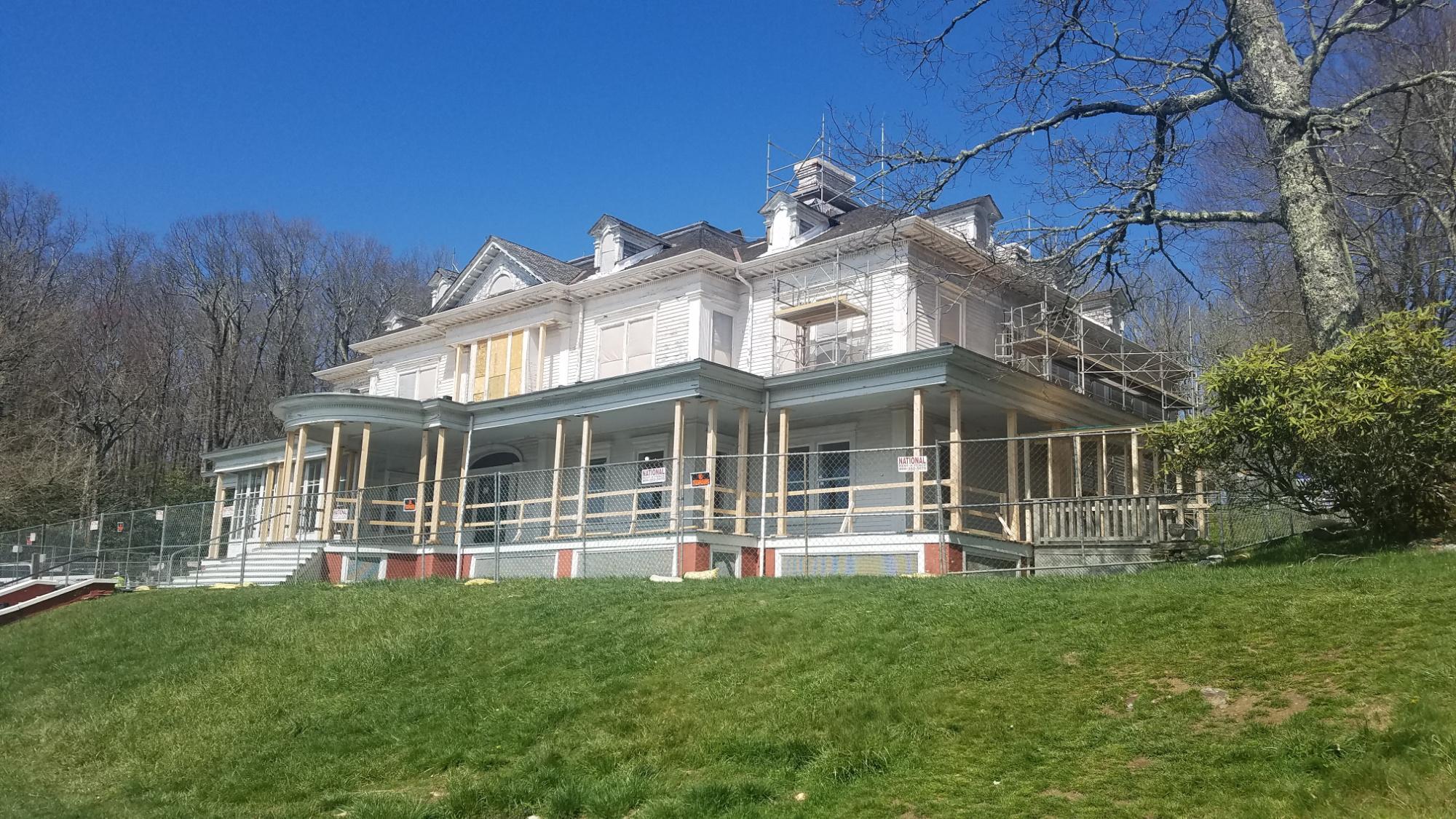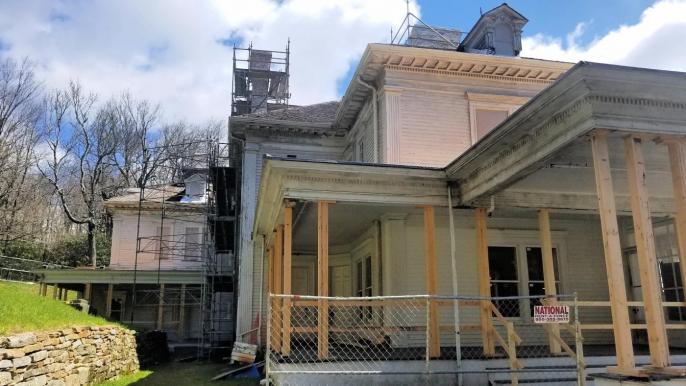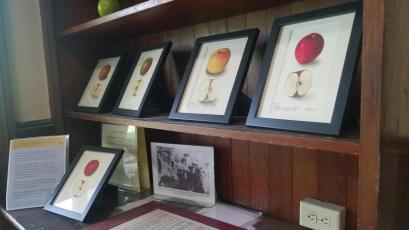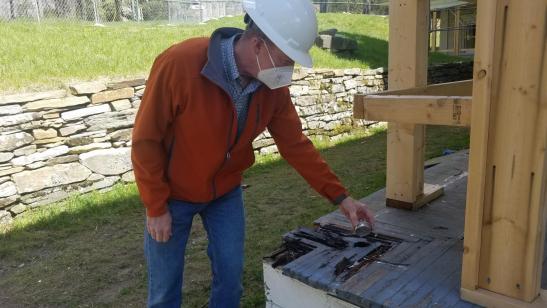
Restoring Americana on the Blue Ridge Parkway
The early 20th-century mountain home of Moses and Bertha Cone is restored to its elegant original appearance.
By Kim O’Connell
On a bluebird-sky day in April, a historic mansion along the Blue Ridge Parkway had turned into a construction zone. Skeletons of metal scaffolding surrounded chimneys. Plywood panels covered up windows. Classical columns were replaced with temporary wooden beams. Chain-link fencing fortressed the whole site, while workers in hard hats busied themselves with various tasks.
Located only a few miles north of the nearly 6,000-foot Grandfather Mountain in North Carolina, this is the early-20th-century home of textile magnate Moses Cone and his wife Bertha. This stately mansion, listed on the National Register of Historic Places, is undergoing a complete restoration, the most extensive work ever completed on the property in its more than 120-year history.
Born in Tennessee into a family of entrepreneurs, Moses Cone made his fortune as a textile manufacturer in Baltimore, eventually becoming one of the most successful denim suppliers in America (one regular customer was Levi Strauss & Co, whose jeans were already in wide usage as work pants). Moses married Bertha Lindau in 1888. Together, they hired architect Orlo Epps to design a second home for them near the town of Blowing Rock, for which work began in 1899 and was complete in 1901. They named it Flat Top Manor after nearby Flat Top Mountain.
Although the manor is frequently described as “Colonial Revival,” architectural historians have reported that it is actually an example of Beaux-Arts design. Boasting 23 rooms, the nearly 13,800-square-foot mansion features a wraparound porch, a semicircular entrance bay, and Ionic columns. According to the National Register report on the manor, the house was replete with modern conveniences, including “tiled bathrooms; a service wing with built-in cabinets, marble sinks, hot and cold running water, and both ceramic tile and linoleum flooring; acetylene lights; a telephone system; and a wood-burning central heating system.”

A side view of Flat Top Manor shows some of the intricate details of the estate's construction. / Kim O'Connell
Moses was a gentleman farmer who wished to showcase the estate’s beauty and functionality, including Bertha’s beloved apple orchards, which stretched as far as the eye could see, and the couple's well-tended flower and vegetable gardens, for which the Cones employed local farmers. Twenty-five miles of the Cones' carriage roads circle the property, and the park preserves a 20-minute walking loop that the Cones purportedly walked together every morning.
“[The Cones] were only here only in the summertime, but as you can see from the view, it is a spectacular place,” says Kevin Brandt, project manager for the Blue Ridge Parkway Foundation, which is leading the restoration, and former superintendent of C&O Canal National Historical Park. “Bertha had a particular interest in raising apples and a very wide variety of apples at that. So, this house is really the platform from which many, many stories can be told by the National Park Service. And so maintaining it in good condition is really important.”
One historical account stated that the estate grew “76 varieties of apples, 20 varieties of pears, 33 varieties of peaches, 10 varieties of plums, and 9 varieties of cherries.” As the Greensboro Daily News wrote in a 1930 retrospective about the Cones, “'If an apple a day keeps the doctor away’ there are enough apples in the Cone orchards to starve thousands of disciples of Aesculapius [the Greek god of medicine]. The Cone orchard is one of the show places of America.”

A display about the many apples once grown on the Cone Estate / Kim O'Connell
Sadly, Moses didn’t get to enjoy the estate for long; he died of pulmonary edema and other health issues in 1908, at the age of 51. Bertha kept the property for years until her own passing in 1947, after which the Cone Trust donated it to a local hospital, which turned it over to the National Park Service in 1950. Both Moses and Bertha are buried in a family plot marked with a large stone monument not far from the manor house.
The 469-mile Blue Ridge Parkway, mostly built between the 1930s and 1960s, came through the estate’s grounds between 1955 and 1957. Today, the manor also houses the Southern Highland Craft Guild, which showcases the work of hundreds of regional artists, including ceramics, woodwork, woven garments, and other mountain crafts.
When I visited in April, spring was just beginning to grip the Blue Ridge Mountains. Despite the fact that the manor was closed during construction, the surrounding 3,500-acre estate (known as the Moses Cone Memorial Park) was still attracting visitors, who wandered the gravel trails that surround the house or picnicked on its bucolic grounds. A dance troupe was even filming a video with the grounds as the backdrop.
For the $2.3 million restoration, which was funded through donations to the Foundation as well as some NPS dollars, windows, porch columns, railings and balusters have all been removed and sent to Double Hung, LLC, a preservation firm in Greensboro, North Carolina, which repaired what could be salvaged. Other pieces, such as deteriorating wood siding, shingles, and doors, will be replaced. Ritz Construction is the head contractor.

Kevin Brandt of the Blue Ridge Parkway Foundation inspects a corner of the Flat Top Manor, now undergoing restoration. / Kim O'Connell
“You wouldn't think that here in the mountains of North Carolina, you would have an extreme environment,” Brandt says. “But it is an extreme environment, because of the amount of rainfall, the temperature range, the humidity, the fact that it'll often sit days in clouds up here when, down at a lower elevation, it's bright and sunny. All of that takes its toll on the wood surfaces of the house itself.”
Although the park store and gift shop in the manor have reopened, restoration work is ongoing through the summer, and the full building is expected to reopen for tours later this year. The Blue Ridge Parkway Foundation has also developed a virtual tour that visitors can access at any time through its website.
“Thousands of people come here each year,” Brandt says. They walk on the trails…they horseback ride on the trails. It's just an absolutely stellar place to come and enjoy the mountains.”
Support National Parks Traveler
Your support for the National Parks Traveler comes at a time when news organizations are finding it hard, if not impossible, to stay in business. Traveler's work is vital. For nearly two decades we've provided essential coverage of national parks and protected areas. With the Trump administration’s determination to downsize the federal government, and Interior Secretary Doug Burgum’s approach to public lands focused on energy exploration, it’s clear the Traveler will have much to cover in the months and years ahead. We know of no other news organization that provides such broad coverage of national parks and protected areas on a daily basis. Your support is greatly appreciated.
EIN: 26-2378789
A copy of National Parks Traveler's financial statements may be obtained by sending a stamped, self-addressed envelope to: National Parks Traveler, P.O. Box 980452, Park City, Utah 84098. National Parks Traveler was formed in the state of Utah for the purpose of informing and educating about national parks and protected areas.
Residents of the following states may obtain a copy of our financial and additional information as stated below:
- Florida: A COPY OF THE OFFICIAL REGISTRATION AND FINANCIAL INFORMATION FOR NATIONAL PARKS TRAVELER, (REGISTRATION NO. CH 51659), MAY BE OBTAINED FROM THE DIVISION OF CONSUMER SERVICES BY CALLING 800-435-7352 OR VISITING THEIR WEBSITE. REGISTRATION DOES NOT IMPLY ENDORSEMENT, APPROVAL, OR RECOMMENDATION BY THE STATE.
- Georgia: A full and fair description of the programs and financial statement summary of National Parks Traveler is available upon request at the office and phone number indicated above.
- Maryland: Documents and information submitted under the Maryland Solicitations Act are also available, for the cost of postage and copies, from the Secretary of State, State House, Annapolis, MD 21401 (410-974-5534).
- North Carolina: Financial information about this organization and a copy of its license are available from the State Solicitation Licensing Branch at 888-830-4989 or 919-807-2214. The license is not an endorsement by the State.
- Pennsylvania: The official registration and financial information of National Parks Traveler may be obtained from the Pennsylvania Department of State by calling 800-732-0999. Registration does not imply endorsement.
- Virginia: Financial statements are available from the Virginia Department of Agriculture and Consumer Services, 102 Governor Street, Richmond, Virginia 23219.
- Washington: National Parks Traveler is registered with Washington State’s Charities Program as required by law and additional information is available by calling 800-332-4483 or visiting www.sos.wa.gov/charities, or on file at Charities Division, Office of the Secretary of State, State of Washington, Olympia, WA 98504.

 Support Essential Coverage of Essential Places
Support Essential Coverage of Essential Places